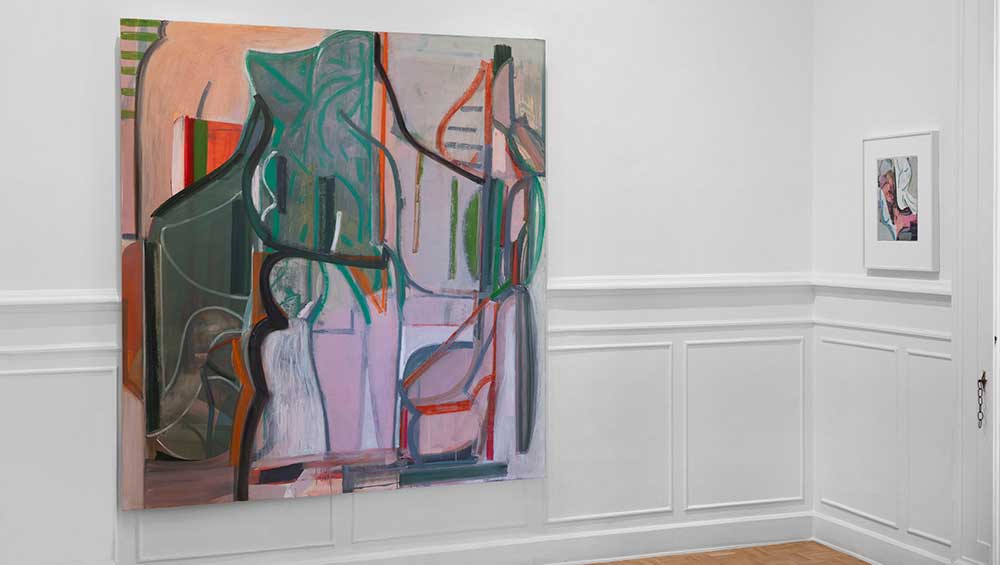
Amy Sillman: Temporary Object, installation view, Thomas Dane Gallery, Naples. © Amy Sillman. Courtesy the artist, Gladstone Gallery, New York and Thomas Dane Gallery. Photo: Roberto Salomone.
by ANGERIA RIGAMONTI di CUTÒ
The late New Yorker critic Peter Schjeldahl called Amy Sillman (b1955, Detroit) “a painting lover's painter, providing kinds of joy that one may be inclined to keep to oneself”, though Sillman is also a writer, drawer, scholar, curator, educator, animator and talker. One of the principal areas of her work in diverse media has been a sustained, tussling engagement with the legacy of abstract expressionism, picking apart and refuting its almost instantly ossified mythology of cold war assertiveness. For Sillman, painting, which she has described as a kind of battleground, is a form to bend to her will, the antithesis of the rarefied and disembodied medium persistently associated with abstraction.
She also picks apart culture’s social sphere in mordant diagrams and cartoons, at times skewering the portentousness of the art world, or comparing the worth of luxury goods such as oil paint, cocaine, perfume and real estate in terms of cost versus longevity and the pleasure each elicits. These components of her work point to the importance of the relationships between people and things for Sillman; everything is vividly personal and human. She has described her paintings as alter egos, abstract expressionism as an uptight ex, and specific colours as having turgid, overbearing, domineering and vulgar characters. Some of her skits are laugh-out-loud funny but, like any good humourist, she also has a penchant for life’s dark spaces, the tragic, but also less heroic human conditions such as awkwardness, embarrassment and oddness, the off-kilter.
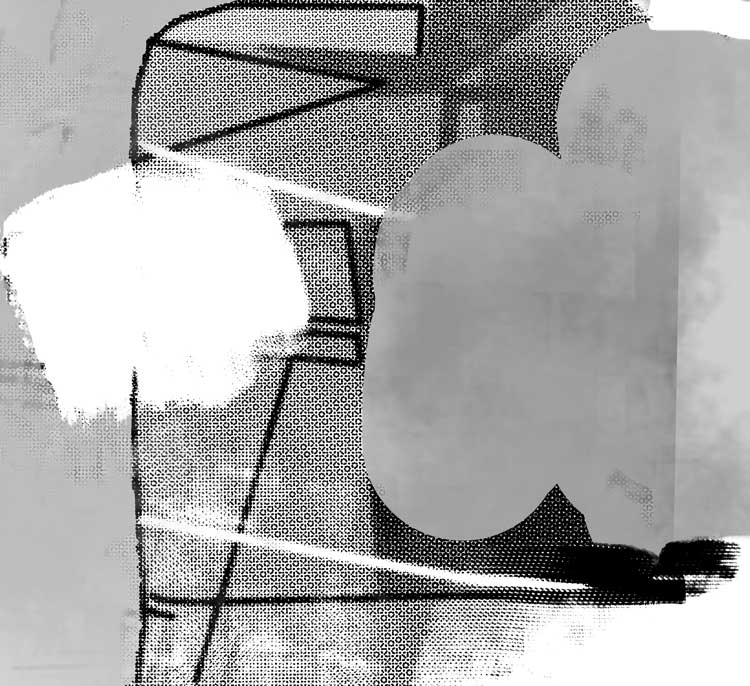
Amy Sillman, Temporary Object, 2023. UV printed on aluminium, one of a set of 41, 25.4 x 27.3 cm (10 x 10 3/4 in) each. © Amy Sillman. Courtesy the artist, Thomas Dane Gallery and Gladstone Gallery, New York.
Temporary Object, an arresting display of recent paintings, works on paper, and a new series of 40 sequential diagrams printed on aluminium, provides a new setting for Sillman to get to grips with the fraught negotiation between art and life.
Sillman answered Studio International's questions by email on the occasion of her current exhibition at Thomas Dane Gallery, Naples.
Angeria Rigamonti di Cutò: Your Temporary Object series of black-and-white images printed on aluminium is displayed in a closely packed row in the exhibition, making it read like a series of cinematic frames. You’ve often exhibited frieze-like sequences of evolving permutations of your works. Are you presenting the viewer with the more commonly behind-the-scenes process of arriving at the image you’re after, assuming there is a final, definitive one?
Amy Sillman: I think in a way, yes! Behind the scenes … not that the viewers need to study the whole process, but I want to instil the idea of “movie” (or “moving picture”) in a viewer’s mind, at least to get at the idea that paintings are elaborate constructions, with so many changes and false starts and byways. I think of them as being a bit like little experimental movies or animations in the studio. I don’t know what I’m going to end up with. So, I love the idea of foregrounding process, and the ways of thinking that lie inside abstraction, to convey what’s at stake in it (the idea of not knowing).
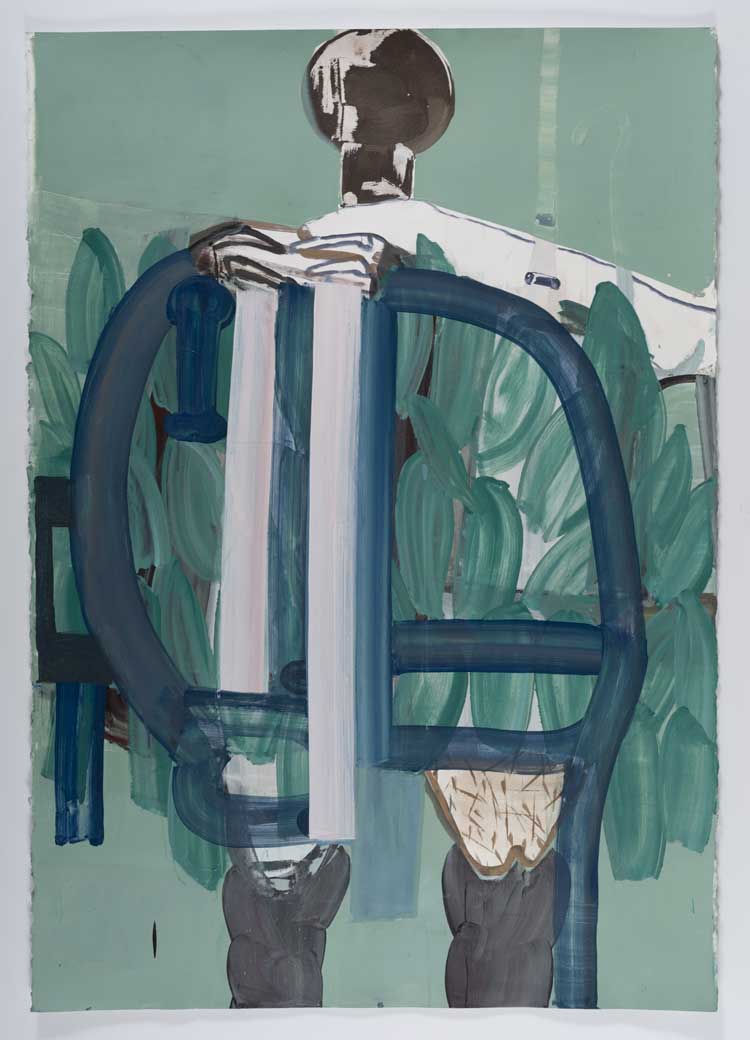
Amy Sillman, Torso with Green, 2023. Acrylic, ink, silkscreen on paper
151.1 x 106 cm (59 1/2 x 41 3/4 in). © Amy Sillman. Courtesy the artist, Thomas Dane Gallery and Gladstone Gallery, New York.
ARC: To what extent, if any, did the Neapolitan location affect this show? Naples is a city that has moved between an outlier and central status, an idea that I think interests you.
AS: Naples as a city or site didn’t affect my thinking because I hadn’t been there yet.
ARC: In reference to your The Shape of Shape MoMA exhibition (2019-20), you said you wanted to convey love and anxiety, arising from the catastrophic state of the world since 2016. That’s a striking and poignant combination of impulses: does the expression of those feelings still drive you, given that things seem only to get worse?
AS: I guess I’d have to answer yes. Love and anxiety are what I think I build my worldview from, or at least those are some of my key positions. I love painting, I love abstraction, I love the history of 20th- century art, I love high art, but I also doubt and feel anxiety about all of that, not to mention the state of the planet. But the flowers keep coming up and we still love and breathe and then die. We’re in this sticky place between despair and vitality all the time, eh?
ARC: Turning to your writing, in Shit Happens, a text you’ve referred to as your manifesto, you expressed your visceral distaste for concepts such as beauty and visual pleasure (“I wanted to barf”). Is visual appeal still “the enemy”; do you really give it no consideration in the construction of your works? You have referred to the beauty of certain colours you’ve made but were then unable to reconstruct as they were composed of so many additions of hues.
AS: Regarding beauty: honestly also yes. I think it’s a dumb goal, though I guess “enemy” is a bit too strong a way to put it? I do think about how to make something that “looks good” to me, but “good” is the thing that is so variable. What is “good”? I think it is when the thing represents some truth about exactly the feelings that drive the answer to your previous question. Love, doubt, joy, enthusiasm, criticality, all at once. When it has energy, when it surprises you, when it welcomes argument, when it is strong.
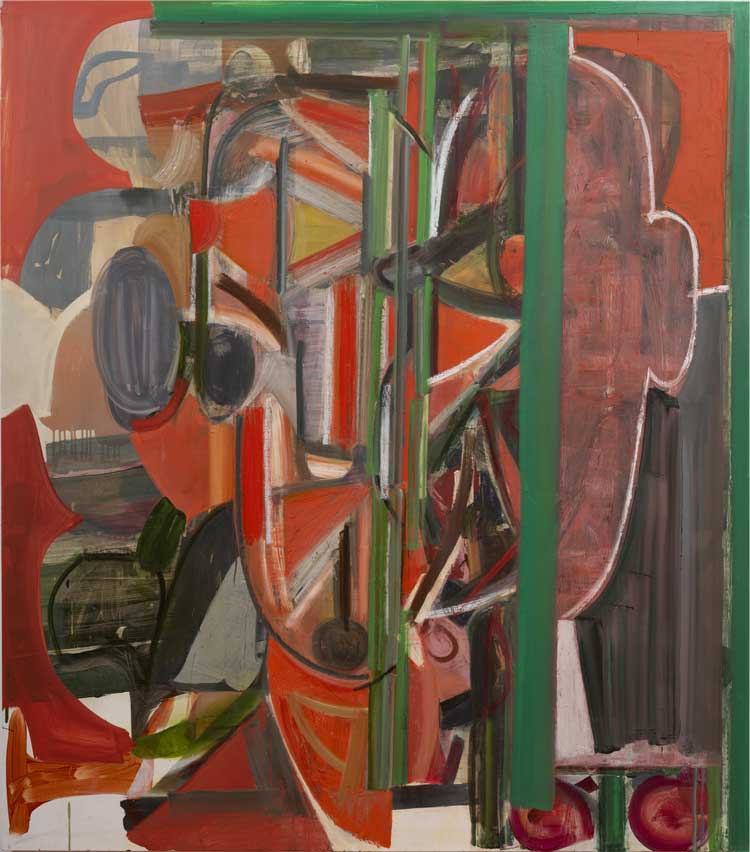
Amy Sillman, Mug, 2023. Acrylic, oil on linen, 190.5 x 167.6 cm (75 x 66 in). © Amy Sillman. Courtesy the artist, Thomas Dane Gallery and
Gladstone Gallery, New York.
I do think there are better and worse paintings, and good and not good drawings. But “beauty” or “skill” is kind of a frozen category, though I’m also impatient with “bad” when all it means is doing the opposite of “good” – when it just means things being shitty, not cared for, not fussed over, when they’re lackadaisical, indifferent, lazy, etc. So, I do hold rather complex views about what’s good – or better – but to strive for beauty is not my thing.
I want strength, vitality, surprise, energy, but “beauty” is usually a frozen or cliched or problematic category. It’s all tough to define precisely because, of course, visual pleasure is as varied and personal as any other pleasure. I know I’m a very intense editor and it’s a good thing in tweaking and constantly trying to make new endings and surprises, but then I’m too uptight and I wreck things and don’t let them breathe. So, everyone has their good and bad stuff …
ARC: One of the cleverest pieces of art history writing I’ve encountered in a long time was your piece on Louise Fishman, Nine Innings: Notes of a Color Commentator. This was a catalogue “essay” written in the form of a baseball match commentary, which you also had read out loud by a professional commentator, with the typically excitable delivery of a sports broadcast, bringing a new spin to the concept of action painting. Have you thought about creating art texts in other genre-bending ways?
AS: I always think of jokes and twists and turns, but [have] maybe not realised such a specific piece of writing as that one so far. Thank you for the compliment. It just flowed out of me naturally in that case – and, luckily, I knew a radio sportscaster. (Per my answer above: I should let it flow more often.) I did once get asked to write an essay about abstraction and in that case had nothing much to say, so I just wrote it in the form of a teenage breakup letter to abstraction as a character named “A”… That one was pretty funny too.
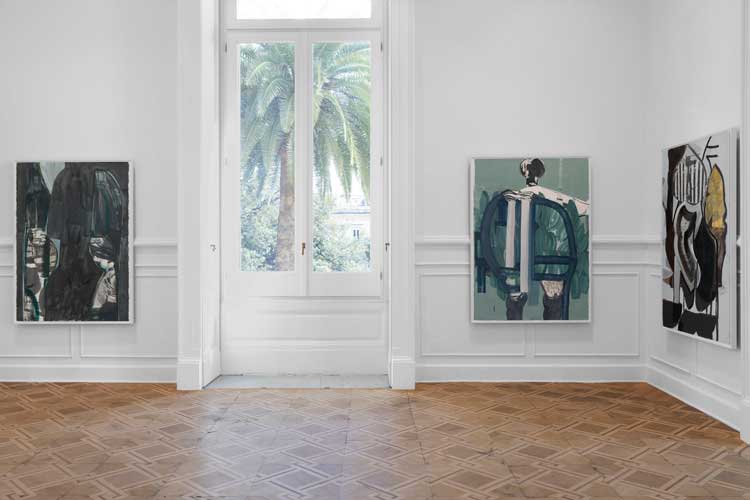
Amy Sillman: Temporary Object, installation view, Thomas Dane Gallery, Naples. © Amy Sillman. Courtesy the artist, Gladstone Gallery, New York and Thomas Dane Gallery. Photo: Roberto Salomone.
ARC: In addition to your writing, you also speak compellingly about your own and other people’s work, as well as on questions such as form, colour and how art history has been constructed. You’ve said that you prefer the spoken form of language to the written one, for its improvisational unpredictability that forces you to respond in the instant, as you would during the painting process. It seems as if painting, writing and talking are co-protagonists of your work, with no clear hierarchy?
AS: That is true! I love to talk, I love to think, read, and write, and painting (to quote Howard Hodgkin) is sheer hell. But that’s why I love it. Painting is a mercurial mistress.
ARC: Another crucial component of your work is humour, an impulse often misguidedly viewed in opposition to “serious” art. In your practice, you use it in caustically funny cartoons and diagrams, often spoofing the art world. You’ve called jokes “the bailiff of high art”; is humour important to you for the distance it creates, giving us another way to see and experience things, as well as obviously having an anxiolytic role?
AS: First of all, I did not know the word anxiolytic, so thank you. I just looked it up. Yes, I think humour is the key to life. I have a theory that funny artists are not as famous until they die and then everyone realises how rare and beautiful the perfume of humour is, and that once the person is gone they won’t have that whiff again. Just a personal theory.
But anyway, I’m Jewish, too, if that matters. I mean I was raised with this absolutely tense family and then an accompanying structure of making jokes to relieve the tension, very common in Jewish and Italian families, and probably many others. I was raised to love jokes, joke-cracking, also sarcasm, irony, buffoonery, language play, puns, love of all games, TV shows, etc. I have the same complex palette for humour as I do painting and drawing standards too: I watch humour all the time and only like some of it (I do not like the Three Stooges, for example, or any slapstick – I just don’t laugh).
I think comedy is divided into awful, pretty good, and then “a cut above”. That’s what I’m always looking for. But then I learned about improv. OMG, improv! It’s stream of consciousness with no punchline. To study it is the most fun thing in the world. I took classes in improv because I wanted to learn how improv was like painting was like free jazz playing was like psychoanalysis. (Freud’s book on jokes, no accident!) So, yes, to humour. Sometimes it’s mean and that’s bad, but humour creates critical distance without too much self-seriousness, at its best, and I think that is the spirit of art, and it’s the flip side of tragedy, which I also love. I love deeply sad things too.
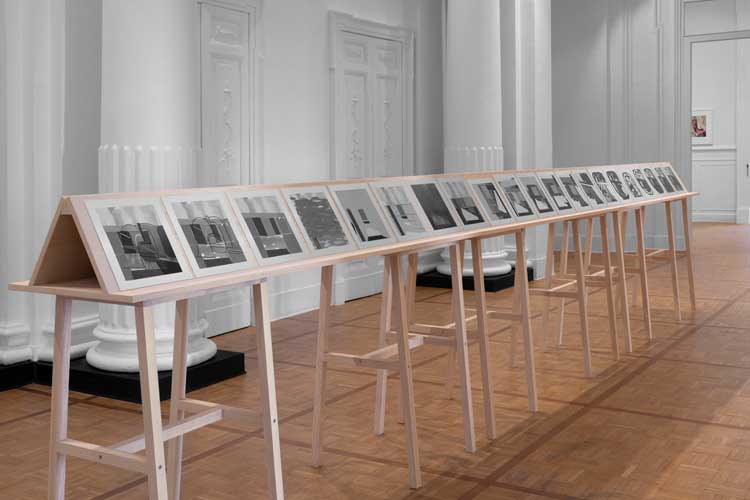
Amy Sillman: Temporary Object, installation view, Thomas Dane Gallery, Naples. © Amy Sillman. Courtesy the artist, Gladstone Gallery, New York and Thomas Dane Gallery. Photo: Roberto Salomone.
ARC: In Shit Happens, you described yourself as a “questioning machine, endlessly discontent”, in the perpetual process of searching for a form that will tell you something you don’t already know. Does the quest ever become less of a struggle; do you feel that you’ve ever grasped that elusive something that you’re after, or is it always out of reach?
AS: Yes, I sometimes nail it. Or get it right after a long time. And that feels exultant! And makes the fussing worthwhile.
• Amy Sillman: Temporary Object is at Thomas Dane Gallery, Naples, until 29 July 2023.